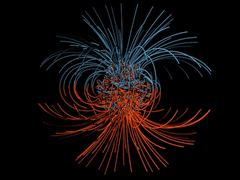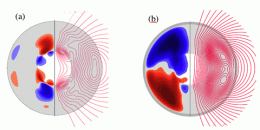Planetary magnetic fields: The hunt for better models

Some three thousand kilometers below the surface of the Earth and with temperatures reaching those at the surface of the sun, the core of our home planet is no more within our physical reach today than it was back when Jules Verne undertook his fictional journey to the center of the Earth. Yet the mysteries still hidden there -- such as how the liquid core regenerates Earth's magnetic life force -- are of far greater interest to scientists today than to any science fiction writers past or present. With the help of increasingly sophisticated computer simulations, Earth scientists have created numerical models over the last decades which, in many respects, are remarkably successful at reproducing key aspects of the magnetic field.
But even the best models today cannot resolve the broad spectrum of turbulence in the interior of the Earth. If these models were to improve significantly, scientists might be able to not only understand the dynamics of the core, but to also explore such far-reaching issues as the habitability of distant planets or the timing of the next polarity reversal here on Earth.
“Understanding the origins of the magnetic field is an interesting scientific question. But there are other reasons for our interest in this topic – bigger issues,” says geophysics professor Bruce Buffett of UC Berkeley’s Department of Earth and Planetary Science. “The magnetic field, especially on terrestrial planets, is a sensitive diagnostic of the internal dynamics of the planet. It may tell us, for instance, about whether plate tectonics exist. Plate tectonics are very good at cooling planets down. Venus probably doesn’t have plate tectonics, Earth does.” And most likely it is not a coincidence that Venus does not have a magnetic field, either.
Many of us take features such as the magnetic field for granted, as an inevitable and indelible feature of our planet. This field, however, and the resulting magnetosphere that protects our home from the solar wind, are the result of a happy set of circumstances that allowed the core to first generate and then continually regenerate the geomagnetic field of the Earth. The conditions necessary for this process to take place include the existence of a large volume of electrically conducting fluid (the liquid iron alloy at the core); the energy to drive this electrical dynamo through convection (the transfer of heat from the bottom to the top of core as the liquid cools); and the rotation that twists this fluid in Earth's core.
“If you turned off the core, the dipole field would disappear in 20,000 years,” Buffett reminds us. “Planets do die. They run out of heat and wind down. So Earth has to keep regenerating.”
Not all planets are as fortunate as Earth in being able to do so. In fact, both of our planetary neighbors, Venus and Mars, lack magnetic fields at the present time. What’s more, geological evidence indicates Mars did have a field once but lost it — and its atmosphere along with it. Geologically it died. Why? By probing the goings-on at the core of the Earth scientists may someday be able to answer such questions.
Yet despites continued advances in technology, our understanding of fluid dynamics in the core of the Earth is still in its infancy. Current models are very good at simulating features that are observable, such as the magnitude of the dipole field, but problematic at reproducing the large-scale flows that are responsible for generating the planet's magnetic field.

“I would claim that the models are very far from being realistic, and therefore the inferences we draw from them about the Earth are going to be questionable,” Buffett says.
The problem with numerical models is that they ignore turbulence, as they do not have enough resolution to resolve fluid motion at small scales. Because the viscosity of the liquid core is so low — more fluid than even water — the stirring motions there span the whole range, all the way down to one-meter scales, which the models cannot handle. To get around this problem, earth scientists increase the viscosity of their models by eight-to-nine orders of magnitude — the equivalent of using ice instead of something more fluid than water.
Suppressing small scales to this extent would be less of a problem if the core were more like the atmosphere, where turbulence is almost isotropic. Small-scale motions cause mixing in all directions, which can be approximated using an “eddy” viscosity. But in the core the strong effects of rotation and magnetic field cause the small-scale motion to very anisotropic: the fluid motion in some directions are much stronger than those in other directions, something current models ignore.
“We would like our turbulence models to properly honor dynamics we know happen at those scales, so when we use them to tell us what happens at the big scales we could have the confidence that we’re right.”
The irony of these models is that in spite of starting out with parameters that are clearly off, such as viscosity and thermal diffusivity, they are still able to reproduce features such the Earth’s observable magnetic field. “The general notion is that the parameters are wrong, but if you get them wrong in the right proportions, everything works out. I’m not so optimistic about that,” Buffett says. “My suspicion is that we might be getting the right answers for the wrong reasons. Getting better models would determine if that’s the case and give us the right answers for the right reasons.”
The reason for Buffett ’s skepticism is that features such as the dipole field are only a small part of a complex story. Scientists can create models that start with very different assumptions about the dynamics of the core yet produce very similar observable results. To illustrate the point, Buffett points to two geodynamo models that exhibit this kind of behavior.
“The fields that come out of the core look like what you’d expect for the dipole. But the way these dynamos are actually working and regenerating the field are very different. So the dipole by itself is not a good discriminant,” Buffett explains.
Another feature these models handle very nicely is polarity reversals on Earth. Just like planetary magnetic fields are not a given, neither is the polarity of the Earth. In fact, Earth has flip-flipped its poles hundreds of times in its history, as recently as 750,000 years ago. Some of the numerical models suggest how these events might happen. “The core is constantly regenerating field, but it starts generating field with opposite polarity. It actively drives the dipole down and then extends it out in other directions,” Buffett says. Rudimentary reversal models simulate “patches” of opposite, or reverse polarity, which eventually grow enough to trigger a spontaneous dipole reversal.

Are we on the brink of such a planetary upheaval? Observations confirm that the intensity of the Earth’s magnetic field is indeed going down. We also know that Earth is overdue for a reversal based on the frequency of reversals over the last few million years. But at this stage of scientific knowledge, our models are not even close to predicting reversals, according to Buffett.
“It’s a valiant effort, but I’m not sure I would necessarily trust the results,” he says. “The only information we have is at the surface. We don’t know much about the pattern of flow or the structure of the field inside the core. I bet if you started with different assumptions about the field inside, it would go different places.”
In order to do that, Buffett says, scientists need to find ways to test models to distinguish between good and bad ones. Specifically, Buffett would like to use variables such as time variation in the magnetic field to build models for the waves that propagate through the core. “We can look at fluid waves sweeping around. How do they relate to what the models predict? Knowing that would give us criteria to determine good models versus bad models,” he says.
Once scientists become more confident in their predictions, Buffett believes, they will start to explore larger topics that, as of now, still lie in the realm of science fiction. For instance, they might look at distant planets — even exoplanets — and make inferences about their structure. Or they might begin to connect the dots between features such as a planet’s magnetic field, the operation of plate tectonics, and climate regulation — thereby establishing a connection between magnetic field and life itself.
“In order to develop life, we need long, stable habitable climate, and plate tectonics is a part of that story,” Buffett says. “Plate tectonics play a huge role in essentially providing a thermostat to regulate climate against changes in solar input. So all these things are potentially linked.”
Buffett is the first to admit these ideas are entirely speculative. But the only way to lift them out of speculative realm, he says, is to create better models of the Earth’s interior. When that happens, he says, scientists will be able to forecast events perhaps 100 years into the future.
“The trick is to look at things under the hood,” he says.
ScienceMatters@Berkeley is published online by the College of Letters and Science at the University of California, Berkeley. The mission of ScienceMatters@Berkeley is to showcase the exciting scientific research underway in the College of Letters and Science and the College of Chemistry.
Provided by ScienceMatters@Berkeley




















